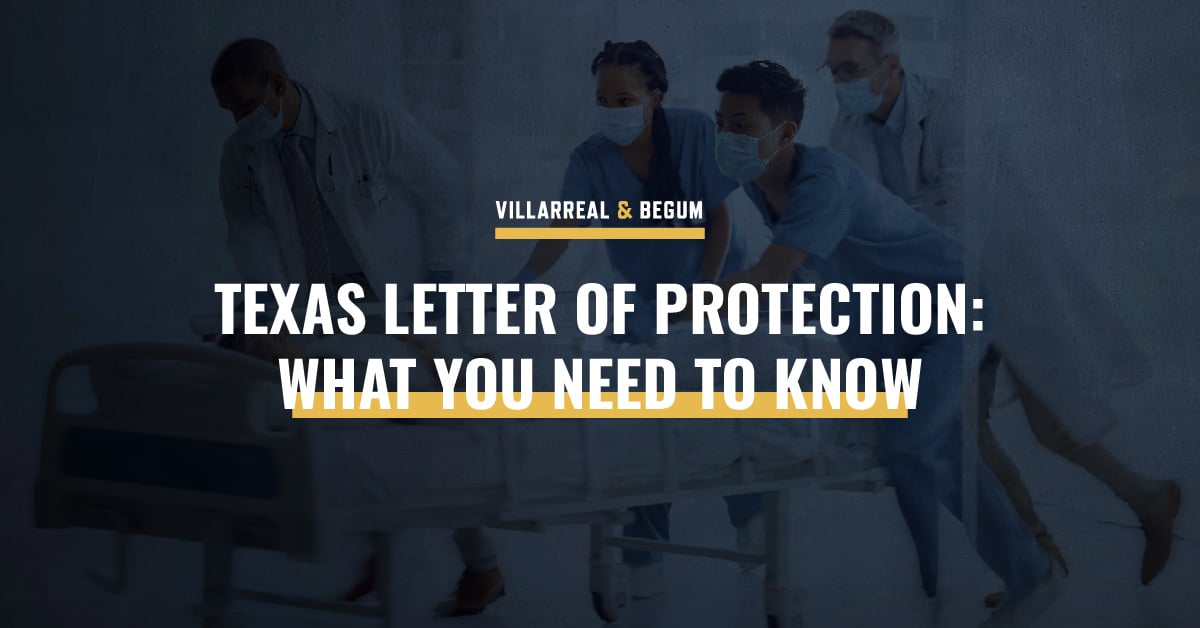Recovering after a preventable injury can be overwhelming, especially when it comes to managing medical expenses and legal matters. Not only is medical treatment expensive, especially for catastrophic injuries, but insurance companies often try to delay or deny claims. Fortunately, this is where a Letter of Protection (LOP) can help.
Understanding the details of a Letter of Protection and its role in your Texas personal injury case is key to ensuring that your rights are protected and that you are making informed decisions about your health care and legal strategy. In this blog, we will break down everything you need to know about Letters of Protection in Texas, from how to obtain one to its effects on your accident injury claim.
What is a Texas Letter of Protection?
A Letter of Protection serves as a bridge between healthcare and legal proceedings, ensuring that injured individuals receive the medical care they need while their case is being resolved. Under this agreement, the medical provider agrees to treat the patient now and wait until the latter is settled for payment. The fees for these medical services come out of any settlement or judgment the accident victim receives from their injury claim.
In Texas, personal injury attorneys use LOPs to ensure that injury victims receive necessary medical attention without the immediate financial burden. The document provides a guarantee to healthcare providers that they will receive payment for their services, albeit at a later date. It is particularly useful when a client does not have health insurance or sufficient funds to cover medical costs upfront.
Below is a general example of what a Texas Letter of Protection may look like:
[Date]
[Medical Provider’s Name]
[Medical Provider’s Address]
[City, State, ZIP]
Re: Letter of Protection for [Client’s Name]
Case: [Case Name/Number, if applicable]
Incident Date: [Date of Incident]
Dear [Medical Provider’s Name],
I am writing on behalf of my client, [Client’s Full Name], who was involved in an incident on [Date of Incident] and has since required medical attention. As you are aware, [Client’s Name] is in the process of pursuing a personal injury claim related to this incident.
Due to the current circumstances, my client is unable to meet the upfront costs for the necessary medical treatment. Therefore, we are requesting that your office agree to provide medical treatment under a Letter of Protection. This letter serves as a guarantee that payment for your services will be made directly from any settlement or judgment obtained in [Client’s Name]’s personal injury case.
We agree that upon the conclusion of [Client’s Name]’s legal case, whether by settlement or court judgment, your office will be paid for all reasonable and necessary medical services rendered to [Client’s Name] from the proceeds of any recovery made in the case. Please understand that this agreement does not absolve [Client’s Name] of their responsibility for these medical charges but rather defers payment until the resolution of the legal matter.
Your office will provide us with periodic billing statements to keep us updated on the costs being accrued. We also agree to notify your office promptly of any resolution in [Client’s Name]’s case.
Please sign below to acknowledge your acceptance of this Letter of Protection and return a copy to our office. We appreciate your cooperation and understanding in this matter.
Thank you for your attention to this matter and for your willingness to work with us under these terms.
Sincerely,
[Attorney Name]
[Law Firm’s Name]
[Contact Information]
Acknowledged and Agreed:
_____________________________
[Medical Provider’s Name/Authorized Signature]
[Date]
When and Why a Letter of Protection is Used
A Letter of Protection is typically used when the injured party doesn’t have health insurance or immediate funds to pay for medical treatment. This is common in preventable accidents or situations where injuries are unexpected. When you’re involved in a personal injury lawsuit, medical treatment can’t wait until the case is resolved: an LOP allows you to receive all necessary care while the lawsuit is ongoing.
Benefits of using a Letter of Protection in Texas include:
- Immediate Medical Care: The primary benefit of an LOP is that it allows an injured party to access necessary medical treatment right away. This immediate care is vital for both health and recovery.
- No Upfront Medical Costs: An LOP removes the burden of upfront medical costs. This is especially helpful for injury victims who might be unable to work due to their injuries and are therefore in a tight financial situation.
- Better Recovery Outcomes: With a LOP, patients can receive medical treatment without being limited by their current financial situation. This can lead to better overall health outcomes.
- Support for a Legal Case: Timely medical treatment ensures proper documentation of injuries, which can be crucial in a personal injury lawsuit. This documentation can strengthen your legal case, especially if an insurance company questions the nature and/or extent of your injuries.
- Reduced Financial Stress: Knowing that medical expenses will eventually be covered through the legal process can significantly reduce stress and allow you to focus on recovery.
How to Obtain a Letter of Protection in Texas
If you’ve been injured and want to file a personal injury claim against the negligent party or parties, the first step is to consult with an experienced attorney who handles such cases. During this meeting, discuss the details of your case and your current medical needs. This is the time to express concerns about your ability to pay for necessary treatment.
The personal injury attorney will assess the merits of your case and determine whether a Letter of Protection is appropriate. If they believe that you have a strong case, they will agree to represent you and proceed with the LOP process.
Attorneys play a crucial role in facilitating the LOP and getting the results you need. They are responsible for drafting the letter, negotiating with your medical providers, and ensuring that the terms are clear and agreed upon by all parties. Your attorney may also help you find a medical professional willing to accept an LOP. (Not all of them accept LOPs, so this step can be extremely important.)
Once a provider agrees to the terms of the LOP, they will deliver the necessary medical treatment, understanding that payment will come later. After your legal case is resolved— whether by insurance settlement or court judgment—the attorney ensures that the medical provider is paid out of the proceeds. Once the medical provider is paid, the Letter of Protection is satisfied and closed.
Responsibilities Under a Letter of Protection
A Letter of Protection (LOP) establishes specific responsibilities for all parties involved – the patient/client, healthcare providers, and the personal injury lawyer. Understanding these obligations is essential for ensuring that the LOP functions effectively and fairly.
Patient/Client Responsibilities
You must provide accurate information about your injury and the circumstances surrounding it, both to the healthcare provider and your attorney. Other responsibilities include:
- Following Medical Advice: It is your responsibility to follow the medical treatment plan and attend all scheduled appointments. Non-compliance can affect both your health and the outcome of your case.
- Communication: You should keep your attorney informed about your medical treatment and any changes in your condition, whether for the better or worse.
- Financial Liability: While the LOP defers payment until the case is resolved, you remain ultimately responsible for all of your medical bills. If the case does not result in a financial award, you may still be liable for these costs. If you have concerns in this regard, be sure to discuss them with your lawyer.
Healthcare Provider Responsibilities
Under the terms of the LOP, the healthcare provider agrees to provide necessary medical treatment to the patient. They should maintain accurate records of treatments and costs and periodically provide these to both you and your attorney. Other responsibilities include:
- Deferred Payment: The provider agrees to defer payment for services until the personal injury case is resolved and understands that payment is contingent upon the success of the personal injury claim.
- Communication with Legal Team: Healthcare providers may need to communicate with your legal team, providing necessary documentation and information relevant to the case.
Personal Injury Lawyer Responsibilities
Your attorney is responsible for drafting the LOP, ensuring it is clear and agreed upon by all parties. They must diligently pursue the legal case to a resolution, whether through settlement or court proceedings. Other responsibilities include:
- Financial Distribution: Upon a successful case resolution, the attorney must ensure that medical providers are paid from the settlement or judgment amount as agreed in the LOP.
- Client Advocacy: The attorney should keep you informed about the case’s progress and advocate for your best interests throughout the legal process.
In summary, the LOP creates a tripartite relationship where each party has distinct responsibilities. The patient/client must be forthcoming and compliant with medical treatment, healthcare providers must deliver care and maintain accurate billing, and legal practitioners must manage the case and financial aspects efficiently. Understanding and fulfilling these responsibilities ensures that the LOP arrangement works effectively for everyone involved.
Closing a Letter of Protection
Once the lawsuit concludes with a settlement or a court judgment in favor of the client, the funds awarded become available to satisfy the LOP. The attorney handling the case will review the total settlement amount or judgment and identify the portion allocated for medical bills as per the LOP.
Your attorney is responsible for ensuring that medical providers who offer services under the LOP are paid. The payment is made directly from the settlement or judgment amount, per the terms outlined in the LOP. After all medical providers are paid, the attorney will finalize your accounts, ensuring that all financial obligations under the LOP are satisfied. Both you and the medical providers should receive a statement from the attorney confirming that all payments have been made and that the LOP is no longer in effect.
Potential Complications and How to Address Them
Sometimes the settlement amount or award may not be enough to cover all of your medical expenses. In such cases, your attorney may need to negotiate with your medical providers to potentially reduce the bills or work out a payment plan.
Disputes can also arise over the reasonableness of the medical charges. If this occurs, your attorney might need to negotiate with the healthcare providers or seek a mediator’s help to resolve the dispute. Other potential complications include:
- Delayed Payments: Delays in settling the LOP can occur due to various reasons. Clear communication from the attorney to all parties involved is essential to manage expectations and provide updates on the payment timeline.
- Client’s Financial Responsibility: If the lawsuit does not result in a favorable outcome, you may still be responsible for the medical expenses. It’s important to understand this possibility from the outset.
Closing an LOP requires careful coordination and communication between the legal and medical parties involved. By understanding the process and potential complications, clients, healthcare providers, and attorneys can work together to ensure a smooth and fair resolution of the LOP.
Questions About a Texas Letter of Protection?
When you’ve suffered catastrophic injuries, Texas Letters of Protection (LOPs) offer a valuable solution, bridging the gap between receiving necessary medical care and the conclusion of a personal injury case. Understanding how LOPs work, their benefits, the responsibilities of each party involved, and the process of closing them is essential for anyone in such a situation.
If you find yourself in a situation where a Letter of Protection might be beneficial, or if you have more questions about how they work in Texas, the team at the Villarreal & Begum, LAW GUNS is here to help. Don’t let the stress of medical bills and legal procedures overwhelm you: let us help you manage your case with the care and expertise you deserve. To schedule your free initial consultation with a personal injury attorney, call (210) 800-0000 or contact us online today.

Alex has tried over 50 trials to verdict and tried or settled over five hundred million dollars in cases. Alexander Begum is a founding shareholder of the Villareal & Begum Law Firm. Born and raised in Texas.





